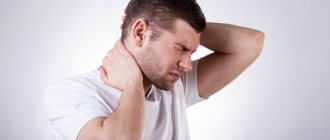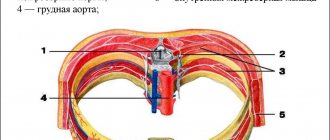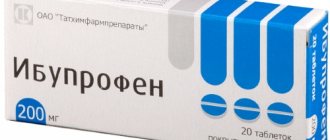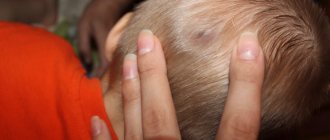Tension headaches affect almost every person throughout their life. This is the most common headache. The exact definition of the disease is very difficult. Therefore, in the literature this pain has received a number of designations: psychogenic, stress, idiopathic pain, etc. in accordance with the International Health Society, the term “tension headache” is used, for the chronic form – “tension episodic headache”.
The disease can be characterized as a dull ache associated with fatigue, often preceded by stress. Usually the attack begins sporadically, sometimes the illness goes into a chronic stage, when the head hurts almost every day, and the initial motivating phenomena are often not defined and not understood.
It hurts mainly in the eyebrow area, often between the eyebrows, in the temple area (both on the right and left side) or forehead.
Pain in the eyebrow area above the eye with or without pressure
People experience headaches or toothaches very often.
It can be eliminated with the help of analgesics and antispasmodics.
But if pain appears in the eyebrow area, then this phenomenon is very alarming. Localization may be over the right or left eye. Such manifestations may be harmless or indicate a serious illness.
Symptoms
Pain tends to manifest itself in different ways. Unpleasant sensations may be periodic or permanent. A person must listen carefully to his body and understand whether something other than pain is bothering him or not. A correct description of the symptoms will help the doctor make an accurate diagnosis. Each pathology is accompanied by characteristic signs.
Name of pathology Symptoms
| Frontit | swelling; sensitivity to light; loss of sensation; fever; pain when pressed in the forehead and eyebrows. |
| Inflammatory processes | pain with sinusitis, sinusitis, runny nose; characteristic dull and aching pain; symptoms intensify with sinusitis. |
| Neuralgic lesions | In this case, the pain is sharp and shooting in nature. A characteristic symptom is pain when pressed, which is accompanied by tinnitus, decreased vision, damage to the optic nerve, and hemorrhage. There is also pain in the eyebrow bone. |
| Migraine | sharp pain that radiates to the back of the head; the attack lasts several hours or days; there is dizziness; tinnitus; nausea, rarely leads to vomiting; increased fatigue, irritability. |
| Meningitis | the pain is bursting; discomfort; decreased hearing and vision; fainting; impaired brain activity; insomnia; Meningitis leads to the development of encephalitis. Treatment takes place in a hospital. |
| Injuries | bleeding; loss of orientation and coordination; nausea; pain and swelling of the eyebrow. |
Each disease manifests itself with characteristic symptoms. This helps the doctor determine the cause of the discomfort. It is strictly not recommended to eliminate such manifestations on your own. Severe illnesses such as meningitis require immediate hospitalization. The disease also has an infectious etiology, and the ability to be transmitted to other people.
Severe eyebrow trauma usually requires stitches. Otherwise, it is impossible to get rid of the cut and characteristic bleeding. Severe, unbearable pain may indicate a traumatic brain injury.
Causes
There are different reasons that lead to pain above or between the eyebrows. The main reasons include:
- infectious diseases;
- migraine;
- presence of tumors in the brain;
- injuries;
- colds.
Each reason for the occurrence of such sensations should be considered in detail. Any pathology can be accompanied by severe complications.
Colds and viral diseases
Colds can negatively affect the functionality of the cardiovascular system, brain, respiratory organs and vision. If you suffer from flu and colds on your feet, there is a high risk of complications. A runny nose and stuffiness are the reason why the brow ridge hurts.
Sinusitis
Sinusitis and sinusitis are complex ENT diseases. Pain in the forehead and eyebrows is typical. There is a risk of eye infection. This can cause serious complications. The pain may spread throughout the head. It is worth noting that such pathologies can lead to sagging eyebrows. The function of the lacrimal glands is also impaired. Against this background, blurred vision appears.
Intracranial pressure
The occurrence of intracranial pressure is a signal of serious illness. It is a mistake to believe that this syndrome can disappear on its own. This only happens with benign diseases.
In other cases, the patient needs to undergo a full examination.
Injuries
Injuries to the eyebrow area are very common. Especially among males. They can be obtained due to the influence of mechanical or physical factors. In addition to pain, there is severe bleeding.
This is due to the large number of blood vessels that are concentrated in this area. Bleeding is dangerous because there is a risk of infection. This can lead to infection with meningitis.
Such situations require immediate medical attention.
Trigeminal neuralgia
This manifestation should be taken very seriously. Neuralgia of such a nerve may be a sign of tumors in the brain. Accompanied by attacks of pain above the eye. Mainly on one side, above the right and left eyebrows. The disease is characterized by a long course, despite drug therapy.
Meningitis
Meningitis and encephalitis are life-threatening diseases. Lack of treatment can lead to the most dangerous complications. Pain in such pathologies is localized in a specific area, most often in the area of the right eyebrow. In addition, the pain spreads to the back of the head and is accompanied by a sharp increase in temperature.
After this, other symptoms will gradually appear: unbearable headaches, nausea, vomiting, indigestion. In some cases, seizures may occur.
A patient with hypersensitivity reacts to light and sounds. Dizziness can lead to fainting. If suspicious symptoms develop, you should immediately consult a doctor. Treatment of these diseases takes place strictly in a hospital.
If your eyebrow hurts when pressed
If pain appears when pressed, then this is mainly a sign of sinusitis, frontal sinusitis or a cold. The area above the eyebrow may swell and pain appears when pressed. Sometimes such manifestations can be a sign of traumatic brain injury.
Diagnostics
Initially, you should consult a therapist. After the examination, the doctor will determine the need for examination by specialized specialists. Mostly laboratory tests, x-rays, ultrasound, MRI, CT are prescribed. If there is a suspicion of the development of meningitis, a cerebrospinal puncture is mandatory. Taking into account the results of these examinations, the doctor prescribes the necessary treatment.
Treatment
After making a diagnosis, the specialist determines therapy. The simplest drugs are nasal drops with a vasoconstrictor effect. Treatment with antibiotics and anti-inflammatory drugs may be necessary to treat serious illnesses. Severe forms of pathologies may require surgical intervention.
Drug group Description
| Nonsteroidal anti-inflammatory drugs | Medicines are taken as first aid for severe pain that has an unknown etiology. They have an anti-inflammatory and analgesic effect. Known medications: Analgin, Aspirin, Paracetamol, Ibuprofen. |
| Medicines containing caffeine | The drugs are taken if the pain is associated with a disruption of the vascular system. They are used for symptomatic treatment as they provide only temporary relief. If the pain does not go away for a long time, you should definitely consult a doctor. A well-known drug from this group is Citramon. It is characterized by high efficiency and low cost. |
| Sedatives | Pharmaceuticals offers a large selection of drugs from this group. They relieve stress, which often causes neurological diseases. They lead to pain, which is localized in the eyebrow area. It is recommended to use the following medications: Persen, Gerbion, Novo-Passit. |
Medicines can be taken as first aid. Pain of different localizations cannot be ignored. Especially if it occurs frequently and does not go away for a long time.
Timely treatment and diagnosis will help avoid the development of a chronic form of the disease and complications. Mostly adults face this problem. Children often suffer from such pain when developing ENT diseases.
Therefore, examination by a doctor is mandatory in any case.
Prevention
Preventive measures should be aimed at preventing any diseases. To do this, a person must lead a healthy lifestyle and eat right. The daily diet should contain the required amount of vitamins and microelements.
Sleep should last at least 8 hours. It is important to avoid stressful situations and nervous tension. This will prevent neuralgia, increased fatigue and colds. Doctors recommend practicing hardening.
This helps strengthen the immune system.
At the first suspicious signs, you should contact a specialist. It is also important to undergo a full examination of the body 1-2 times a year. This will help to detect the disease in time and begin effective treatment.
Poor vision significantly worsens the quality of life and makes it impossible to see the world as it is.
Not to mention the progression of pathologies and complete blindness.
MNTK "Eye Microsurgery" published an article on non-surgical restoration of vision up to 90%, this became possible thanks to...
Read more Was this article helpful?
Rate the material on a five-point scale!
( 1 4.00
Source: https://proglazki.ru/simptomy/bolit-brov-nad-glazom/
Reduced discomfort when pain occurs
For tension cephalgia, regular painkillers such as Aspirin and Ibuprofen will help. Migraine relief requires prescription medications, rest in a quiet, dark room, neck compresses, massage, or even a small amount of caffeine. Treatment for sinus pain includes inhaled oxygen through a mask or preventive medications.
But not everyone automatically tries to take the pill, especially if the child has a headache. There are also methods that can relieve pain without having to attack the nervous system:
- Add liquid. Hand on heart, answer how much water did you drink today? Did you know that approximately 2/3 of your total water intake should be drunk before lunch?
- Add minerals. In particular, magnesium. Its deficiency increases nervous irritation, any pain occurs more easily.
- Reduce tension. Many health problems are caused by stress, so try to either find ways to relax or reduce the effects of stress.
- Go for a walk. Active movement that accelerates blood circulation, relaxation, ideally in nature, are good methods for treating and preventing cephalalgia. Nature is not mentioned just out of habit, being surrounded by greenery has been proven to have an extremely positive relaxation effect on brain activity!
- Click the desired point. Press a point just below your nose or between your eyebrows. This method will help, regardless of whether the right eyebrow hurts or the left one - it will relieve discomfort throughout the head.
Dangerous symptom – pain above the eyebrow on the right
The most complete article on the topic: a dangerous symptom - pain above the eyebrow on the right and a little more for real beauties.
Headache in the eyebrow area can have hundreds of causes - from overwork to a malignant tumor. The eyebrow twitching is also not because you feel great. However, unpleasant symptoms can be classified into groups for a more successful search for treatment. This is exactly what we will talk about next.
Headaches, depending on the nature of the sensation and location, can tell a lot about your body.
Warning, toxic substances
So, let's start with perhaps the most common household cause - poisoning with toxic compounds. No, no, you shouldn’t remember all the horror films in which toxic waste turned people into mutants.
Compounds of this kind are conveniently located in small concentrations on your bathroom shelf, for example, in the form of washing powder. Fabric dyes, plastics, and even children's toys fall into this category.
How often do you look at the ingredients when purchasing products? Never? But the price of such negligence is your health.
The only advice in this situation would be to pay close attention to the quality of the goods purchased. Avoid buying products and things with a strong aroma, even if at first you find it pleasant.
The situation with the composition of food products looks no less depressing. Repeated studies have proven that nitrites, nitrates, monosodium glutamate and tyramine are the main culprits of headaches, allergies and poisoning.
ENT knows why my head hurts
Photo instructions clearly demonstrating changes in the sinuses with sinusitis
Frontal sinusitis, sinusitis, ethmoiditis... This list can be continued for a long time, but all these diseases are well known to otolaryngologists.
In most cases, in addition to headaches, the temperature rises and nasal discharge appears:
- Sinusitis is a fairly common disease that can be recognized by pain around the eyes, in the forehead and temples, elevated body temperature and purulent nasal discharge.
- Frontit. The pain intensifies in the morning and subsides during the day. This process is explained by the outflow and filling of the frontal sinuses with purulent contents.
- Ethmoiditis or inflammation of the ethmoid sinus. The disease often targets preschool children, as well as adults with a very weak immune system. Pain in the superciliary area occurs in the morning and may be accompanied by signs of general intoxication.
- During the autumn-winter period, many people have to deal with colds, flu and acute respiratory viral infections. In most cases, these diseases begin with a headache that occurs in the area of the temples, forehead and around the eyes, and later symptoms of the presence of the virus appear.
Meningitis is characterized by dislocated pain and requires immediate medical attention
- Encephalitis and meningitis differ in the localization of pain in the same place. Neurological symptoms and loss of consciousness may occur.
Quite rare diseases - Rift, Germiston, Dengue, Ilesha, Marituba, Ithaca, Kathu fevers - are carried by mosquitoes and ticks of southern countries and choose their victims among tourists. They have quite serious consequences and require prompt attention to an infectious disease specialist.
Don't joke with your nervous system
Some other diseases associated with pain and eyebrow loss:
- Cluster pain in the eyebrow area is a throbbing pain, accompanied by redness of the eyes and lacrimation. Appearing suddenly and also suddenly disappearing, they can have different intensities, sometimes gaining such strength that they do not allow you to fall asleep.
The nature of such pain is unknown to medicine, but provoking factors include drinking alcohol, smoking and sudden climate change. Often exacerbation occurs in the autumn-spring period.
- Optic or trigeminal neuralgia. The localization of pain occurs along the trigeminal nerve, most often it is a sharp, shooting, stabbing sensation that occurs when touched or a sharp temperature change.
Migraine is a disease that is “getting younger” and is increasingly observed at the age of 23-35 years
- Migraine is a disease that affects every tenth person on the planet. Severe throbbing pain begins in the temporal zone, gradually spreads to the orbit and forehead, most often manifesting itself on one side.
In addition to headaches, migraines can be recognized by tinnitus, nausea, weakness, dizziness and the appearance of “pins and needles” before the eyes.
Bruises and concussions
Loss of consciousness after a bruise is the first sign of a concussion
A slight bruise may cause temporary pain, but when it comes to a concussion, qualified help will be required. A concussion can be recognized by vomiting, nausea, decreased visual acuity, dizziness and loss of consciousness. The only correct action is to immediately contact an ambulance.
Treat osteochondrosis
Does your head hurt above your right eyebrow, is it difficult to bend forward, and do you hear a crunching noise when you turn your neck? You will probably have to deal with osteochondrosis of the cervical spine.
Osteochondrosis of the cervical spine over the past ten years has become one of the most common diseases affecting residents of megacities.
In this case, the headache is in the area of the right eyebrow due to pinching and compression of the spinal cord roots. The pain is described as pressing, aching, pulling, shooting. In addition, there is a lack of coordination of movement, tinnitus and dizziness.
Remember to rest
We often undermine our own health with our own hands, forgetting that the body requires complete, systematic rest.
Unfortunately, modern man has an extremely unbalanced work and rest regime. Constantly being in a sitting position leads to tension in the neck muscles, which, in turn, causes pain spreading from the neck to the temples, forehead, and eyes. Pressing sensations may be accompanied by dizziness and nausea.
Note! Similar symptoms accompany long-term stressful situations and short-term intense nervous tension.
Conclusion
Now you know that “pain above the right eyebrow” is far from a harmless symptom that requires finding out the cause and treatment.
Source: https://resnicyguru.ru/opasnyy-simptom-bolit-nad-brov-yu-sprava/
The child's eyebrow hurts from the inside. Why do the brow ridges hurt? frontal sinusitis: causes
A headache above the eyebrow is an unpleasant symptom that is accompanied by an increase in body temperature, blurred vision, and a runny nose. These sensations cause inflammation or fatigue. Soreness in the forehead above the eyebrows appears due to the following factors:
- Fatigue, tension in facial muscles.
- Inflammatory diseases of the frontal sinuses, colds, flu.
- Allergy.
- Tumors.
- Injuries.
- Neuralgia.
- Circulatory disorders.
- Cluster headache, migraine.
Tensor headache
Pain in the eyebrows and above them is one of the signs of overwork after a hard day at work, negative emotions, anxiety or stress. A lack of certain macroelements after taking glucocorticoids and diuretics sometimes causes such symptoms. Tension of facial muscles leads to their fatigue and unpleasant sensations.
The phenomenon is called tensor headache. In this case, you need to contact a neurologist. For treatment, drugs that relax facial muscles are used - muscle relaxants, sold strictly by prescription (Sirdalud). Supplements containing potassium and magnesium can help reduce cramps.
Inflammation
With colds, flu and other respiratory infections, accompanied by an inflammatory reaction, swelling, fluid containing leukocytes accumulates in the frontal sinuses. This disease is called frontal sinusitis. Inflammation of the frontal sinuses is accompanied by the following symptoms:
- Headache above and between the eyebrows when bending the body forward or walking.
- Possible increase in temperature.
- Runny nose, watery eyes, cough, red throat.
- Weakness, intoxication.
- Toothache, nasal congestion.
- Drowsiness.
The nasal cavity communicates with the frontal sinuses, so when you have a runny nose, inflammatory exudate gets into them, causing a headache between the eyebrows. These cavities are empty in healthy people, but in case of frontal sinusitis they are filled with discharge, which gives all the symptoms.
Often, with a runny nose, inflammation of both the frontal and maxillary (maxillary) sinuses is simultaneously observed. In this case, there is a headache in the eyebrow area, upper teeth, a herpetic rash on the lips, watery eyes, and purulent discharge from the eyes are possible. Intoxication syndrome is accompanied by a rise in temperature, weakness, chills, and increased sweating.
Treatment of colds and inflammatory diseases is a matter for the doctor. For ARVI and bacterial rhinitis, anti-inflammatory drugs are prescribed: Paracetamol, Aspirin. To eliminate swelling of the nasal mucosa, vasoconstrictor drops are used: Naphthyzin, Xylometazoline.
If a viral infection is joined by a bacterial one, antibiotics are prescribed. Before antibacterial therapy, tests are carried out for inflammatory pathogens and their sensitivity to drugs.
For sinusitis, the sinuses are washed with solutions of Furacilin and other antiseptics using the “cuckoo” procedure. In case of a bacterial infection, oil solutions with antimicrobial activity (Pinosol) are dripped into the nasal cavity.
Allergy
The brow ridges hurt when pressed with hay fever, reactions of individual intolerance to food products, hygiene products, plant pollen, animal hair. In this case, inflammatory exudate accumulates in the nasal cavity, as well as in the paranasal sinuses.
The allergy is manifested by lacrimation, pain in the eyes, sneezing, coughing, and sometimes swelling of the nasopharynx and larynx, which can be dangerous due to the development of Quincke's edema and suffocation. Therefore, at the first symptoms you should consult a doctor.
In case of allergies, antihistamines are used: Erius, Cetirizine, Suprastin. In more severe cases, adrenaline and glucocorticoid drugs are used to relieve laryngospasm and anaphylactic shock.
Tumors
The eyebrow hurts when pressed due to oncological processes of bone tissue, skin, mucous membranes of the frontal sinus, and eyes. Fainting is possible, since the process is localized in the head and possible compression of blood vessels and blurred vision.
If a tumor is suspected, a full examination is necessary, including magnetic resonance imaging, general urine and blood tests.
Injuries
Blows to the face are the most common cause of headaches in the forehead and eyebrows. Cold compresses with ice are used for pain relief for closed injuries. Naturally, if you have bruises or concussions, you should seek medical help.
Neuralgia
The inflammatory process affecting the nerve responsible for the skin sensitivity of the area above the eyebrows leads to headaches. The provoking factor is hypothermia, herpetic infection. Symptoms of neuralgia are eliminated by taking anti-inflammatory drugs and physiotherapy.
Blood supply problems
The head has a developed network of blood vessels that supply the face, brain, and eyes. If blood circulation is impaired, pain may occur. Symptoms may appear after taking oral contraceptives, during pregnancy, when there is a tendency to blood clots. Stress causes vasoconstriction, which interferes with normal blood circulation and causes pain.
Cluster headache
It is usually localized in the eyes and above them; the brow ridges may hurt. Usually men of strong physique who abuse tobacco products are prone to this. Preceded by an aura - increased photosensitivity, irritability, blurred vision, drooping eyelid, narrowing of one of the pupils.
Treatment is indicated by taking anti-migraine drugs triptans and ergotamine derivatives as prescribed by a neurologist.
Conclusion
If there is pain above the eyes, you should consult your doctor for further advice. Studies such as MRI, CT, electro- and echoencephalography may be needed. Self-medication is unsafe for health.
Headache is familiar to every person. From time to time, each of us has pain in the temples, back of the head, crown, and frontal part. These manifestations have already become commonplace and rarely cause particular concern.
But why does the eyebrow above the eye hurt? Pain in the brow ridges occurs quite rarely, so when they appear, many people panic and try to establish the causes of such unusual discomfort.
Why does my eyebrow hurt?
The brow ridges are part of the frontal lobe of the skull. In this area there are many small vessels, which, when narrowed and dilated, can lead to pain in the eyebrow area. The main reasons contributing to the development of pain syndrome include:
- migraine;
- injuries;
- intracranial pressure;
- flu, colds;
- neurological diseases;
- osteochondrosis;
- intraocular pressure.
Each of these factors has its own symptoms and etiology, so below we will consider them in more detail.
Migraine
The scourge of our time, which more often affects the female half of humanity, is migraine. Genetic factors play an important role in its occurrence, and the disease is transmitted mainly through the female line.
A characteristic symptom is severe throbbing pain in one side of the head, which is accompanied by photophobia, aversion to loud sounds, nausea, irritability, and dizziness.
Often when attacks occur, a person experiences pain above the eye under the eyebrow, and also worries the eyeball itself and the temple located nearby.
Sinusitis
Pain syndrome often occurs due to inflammation of the maxillary sinuses, which in medicine is called sinusitis. In addition to discomfort in the eyebrows, the disease is characterized by the following symptoms:
- and the eyeball;
- the occurrence of nagging pain when bending the body;
- runny nose;
- nasal congestion;
- fever, chills.
The main source of sinusitis is a viral or bacterial infection, although it sometimes develops as a response to an allergic reaction.
Intracranial pressure
Another reason why the eyebrow hurts is intracranial pressure, and characteristic symptoms can occur with both increased and decreased types.
- When pressure increases,
a person also feels pain in his temples. Its culprits include hypertension, kidney disease, vegetative-vascular dystonia, osteochondrosis of the cervical spine, and overwork. - With a decrease in pressure,
the pain syndrome has a girdling character, and more often manifests itself in the morning or when taking a vertical position. The causes of the pathology are fatigue, vitamin deficiency, atherosclerosis, intoxication, vascular and heart diseases.
Source: https://bmxx.ru/other-diseases/u-rebenka-bolit-brov-iznutri-pochemu-bolyat-nadbrovnye-dugi-frontit/
Do you have a headache above your eyebrow or forehead? Find out more about tension headaches
Tension headaches affect almost every person throughout their life. This is the most common headache. The exact definition of the disease is very difficult.
Therefore, in the literature this pain has received a number of designations: psychogenic, stress, idiopathic pain, etc.
in accordance with the International Health Society, the term “tension headache” is used, for the chronic form – “tension episodic headache”.
The disease can be characterized as a dull ache associated with fatigue, often preceded by stress. Usually the attack begins sporadically, sometimes the illness goes into a chronic stage, when the head hurts almost every day, and the initial motivating phenomena are often not defined and not understood.
It hurts mainly in the eyebrow area, often between the eyebrows, in the temple area (both on the right and left side) or forehead.
Pathogenesis
There are many factors involved in the pathogenesis of tension cephalgia. Hereditary predisposition has not been proven, as has hormonal dependence. On the other hand, psychosocial stress, domestic disputes, non-physiological work position, anxiety, depression and various emotional influences are indicated.
When studying the pathogenesis of tension cephalgia, attention is focused, in particular, on changes in tone and blood circulation in the muscles, changes in blood flow in the vessels of the brain and biochemical changes in the blood. Some of the results may help identify and understand the mechanisms that influence the occurrence of headaches.
Clinical signs
The pain is usually bilateral, most often it hurts in the forehead and temples, between the eyebrows, less often it hurts in the occipital region; The pain is stable, but may fluctuate in intensity. The onset is usually gradual.
This phenomenon distinguishes the disease from a typical migraine attack, which is characterized by pain in one half of the head, mainly in the temple area, rarely in the area between the eyebrows.
Headache (in the forehead, temples, or between the eyebrows) lasts for several minutes to days (30 minutes to 7 days), often occurring at night or in the afternoon.
Frequent various sensations in the head area: patients complain of a feeling of pressure, a hard hoop around the head, sensitivity is often manifested and the scalp hurts when combing, and there are frequent cases of stiff neck muscles.
The trigger for pain in the area between the eyebrows can be not only stress itself, but also the anticipation of stress and repeated conflicts. Provoking moments can be small but frequent daily troubles.
Accompanying symptoms may include mild photophobia and phonophobia, nausea is no exception, and there is no vomiting. Along with headaches, depression and anxiety may occur, especially in chronic conditions, sleep disturbances are common.
Fatigue and dizziness may occur. Subjective symptoms increase with physical activity or alcohol consumption.
According to the international classification of headaches, tension pain must meet the following criteria:
1. Recurrent episodes of pain that last from a few minutes to several days.
2. Intensity – weak or moderate.
3. Localization is two-way.
4. The pain does not worsen with physical activity.
5. Nausea, phonophobia or photophobia are also not uncommon.
6. Attacks occur less than 180 times a year, respectively, less than 15 times a month.
Differential diagnosis
For the differential diagnosis of headache, the most important is the medical history. Many specialists use questionnaires in which the patient fills out basic data, after which, over the course of several months, the characteristics of the attacks are recorded.
It is always necessary to exclude other causes of headache. The doctor inquires about the past history of injuries, especially to the cervical spine, and the presence of prolonged work in a fixed position.
It is necessary to eliminate inflammation of the conjunctiva or paranasal sinuses, refraction, and glaucoma. Myofascial dysfunction may occur in the area of the temporomandibular joint.
When these disorders are observed, the sensitivity of the joints and the presence, sometimes barely audible, crunching sound while moving the stethoscope are examined.
Spondylosis of the cervical spine causes cervicocranial syndrome. Dental disorders, especially in the upper jaw, can also be reflected by pain in the head.
Drug abuse should also be excluded. The cause of pain is mainly caffeine, Aspirin, Ibuprofen, sleeping pills, barbiturates.
Hypothyroidism can cause muscle pain and chronic headaches.
It is always necessary to repeat the diagnostic differential consideration if there is a change in the nature of the painful sensations.
Therapeutic methods
The acute and sporadic type of the disease is usually not a problem and is helped mainly by common analgesics, rest and avoidance of stress. NSAIDs (Ibuprofen, Naproxen) may show better effectiveness than acetylsalicylic acid. Sometimes their combination with muscle relaxants is suitable.
In the case of simple analgesics (Aspirin, caffeine), caution should be exercised with repeated doses if pain recurs. Cases of addiction are common. Amitriptyline is suitable for depressed patients.
Much more difficult is the treatment of chronic pain. It should always be based on a thorough examination followed by an interview with the patient aimed at uncovering the underlying cause of the disease and determining next therapeutic steps.
Most often, a combination of psychological, physiological and pharmacological therapy is used.
Various relaxation exercises and biofeedback (biofeedback - effective for motivated patients) show effectiveness.
The following therapeutic regimen can be used during treatment:
1. Simple analgesics - acetylsalicylic acid, Paracetamol.
2. Combined analgesics.
3. NSAIDs - Ibuprofen, often in combination with acetylsalicylic acid, Indomethacin.
4. Muscle relaxants – Mydocalm, Diazepam, Baclofen, Sirdalud.
5. The following possible methods of treatment are magnesium preparations, antihistamines, sympatholytics.
6. Symptomatic therapy - antiemetics, ergot derivatives, corticosteroids, neuroleptics, sleeping pills, tranquilizers (benzodiazepines, Meprobamate).
The opinion on taking Ergotamine during hospitalization is not clear; according to some authors, ergot derivatives are ineffective. Opiates, codeine, barbiturates, and antipsychotics are also relatively ineffective.
For the purpose of preventive therapy, tricyclic antidepressants and beta blockers are often prescribed (Amitriptyline 100-200 mg/day + Propranolol 60 mg/day). You should start with the minimum effective doses of Amitriptyline (10-25 mg) for the reason that even this dose may be sufficient. If prophylaxis does not show an effect, Valproate can be tried.
Other supportive therapeutic methods: treatment of local pain points:
1. Local anesthetic injections.
2. Peppermint oil (10 g per 100 g of 90% alcohol); its use provides muscle and mental relaxation.
Recently, there have been frequent cases of using hypnotic analgesia. Acupuncture requires long-term treatment (1 to 12 months), after which the intensity, duration, frequency of pain and analgesic consumption are reduced.
Source: https://zen.yandex.ru/media/id/596a6a468146c12e34f9afda/5978a0651410c3ccd2b85fcd
Why do the brow ridges hurt: causes, possible diseases, treatment – World of Health
A headache above the eyebrow is an unpleasant symptom that is accompanied by an increase in body temperature, blurred vision, and a runny nose. These sensations cause inflammation or fatigue. Soreness in the forehead above the eyebrows appears due to the following factors:
- Fatigue, tension in facial muscles.
- Inflammatory diseases of the frontal sinuses, colds, flu.
- Allergy.
- Tumors.
- Injuries.
- Neuralgia.
- Circulatory disorders.
- Cluster headache, migraine.
Headache in the eyebrow area: 8 main causes of discomfort
Pain above the eye in the eyebrow area is a symptom of a variety of causes, ranging from colds to tumor processes. Neurological disorders occupy a leading position among the factors causing pain in the brow ridge. If discomfort periodically appears above the eye, which radiates to the temporal and frontal regions, then it is important to consult a neurologist.
If the unpleasant sensation appears for the first time, it is relieved with the help of antispasmodics. In the future, all therapeutic measures are carried out under the supervision of a specialist, otherwise you will seriously harm yourself.
Painful sensations are called primary and appear as a separate pathology, as well as secondary - they arise against the background of another process. The main causes of this type of pain are diseases of the ears, nose, jaw, pinched nerves, high blood pressure, hormonal changes and more.
Frontit
The pathology most often appears as a complication of sinusitis, but can also occur as an independent disease. The frontal sinuses are located in the eyebrow area, on either side of the center of the face.
© shutterstock
Where to contact
When the pain above the eyes in the eyebrow area intensifies when pressed, you should visit an otolaryngologist.
Cervical osteochondrosis
Disease in the upper part of this spine can cause pinching of a nerve root in the back of the head.
© shutterstock
Who will help
When your eyebrow hurts due to osteochondrosis, you need to visit a vertebrologist or neurologist.
Provoking factors
The causes of damage to the upper part of the trigeminal nerve are different. Commonly encountered ones include :
- hypothermia;
- bruises of the eyebrows and forehead;
- infectious inflammation of soft tissues (most often provoked by the herpis virus);
- neoplasms;
- vascular spasms.
Often the cause of the development of neuralgia of the upper part of the nerve is atherosclerosis of cerebral vessels or disturbances of cerebral blood flow.
High blood pressure
Another serious reason why the forehead hurts between the eyebrows is increased intracranial pressure. This happens to those who suffer from high blood pressure. This category includes hypertensive and hypotensive patients. This also includes people who are sensitive to changes in weather phenomena. People who suffer from high blood pressure should definitely buy a device to measure it. If the pressure rises, then special measures should be taken to normalize it. These include taking special medications.
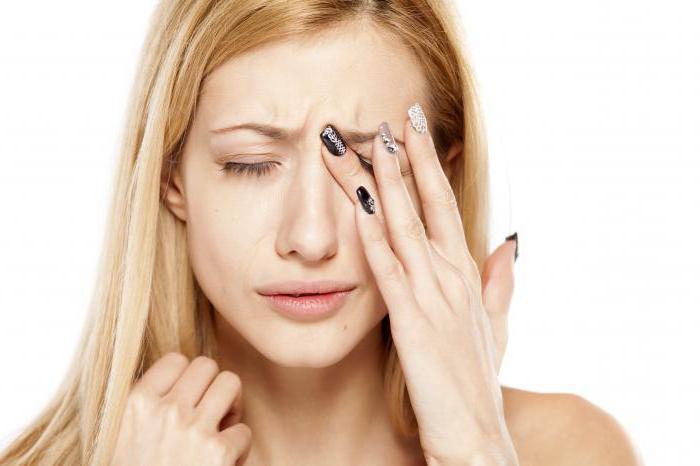
Under no circumstances should you self-medicate or take medications that have not been prescribed by a doctor. You should control your blood pressure. It is also necessary to contact a medical institution for consultation, examination and prescription of medications, which will be selected individually, taking into account the characteristics of the human body. When pain occurs between the eyebrows, you must first measure the pressure and take the necessary measures to stabilize it. If you cannot cope on your own, then you need to call a doctor.
Why pain occurs above the eye in the eyebrow area: causes, diagnosis, therapy, prevention
The main factors that can cause pain above the eye in the eyebrow area include neurological disorders. What should you do if pain and discomfort periodically appear above the eye, if the unpleasant sensation radiates to the temple or forehead area, and which doctor should you contact?
Causes of pain above the eye
Few people pay attention to pain in the eyebrow area, attributing it to a temporary phenomenon that will go away on its own. However, such pain can signal the presence of various diseases, both a common cold and serious malignant processes.
Soreness in the eye area is caused by the structure of the human skull; it is in this area that there is a large accumulation of various ducts and sinuses. Depending on the specific location of the pain, you can talk about possible factors that provoked the discomfort. Pathologies can be either neurological or infectious.
Infectious pathologies can theoretically be divided into 2 parts - neurological, that is, diseases of the central nervous system, and infectious. Diseases of the first type include encephalitis, meningitis, and the second - sinusitis, profilitis, frontal sinusitis, and so on.
There are situations when pain in the eyebrows and eyes is not pathological. Most often this is observed as a result of alcohol poisoning, smoking, which often provokes vasospasm and hypoxia, due to poor diet, long and regular work at the computer, and as a result of mental stress.
Symptoms of pathologies that cause pain near the eyebrows
Pain under or near the eyebrow can be a sign of various pathologies within the body. Sometimes this kind of pain can signal the presence of serious pathologies. In this case, in addition to pain around the eyes and eyebrows, concomitant symptoms may also be observed. Most often this includes:
- swelling of the mucous membranes;
- fear of light;
- swelling of the eyelids;
- the appearance of tinnitus;
- severe dizziness, which may occur along with vomiting;
- insomnia;
- constant feeling of fatigue;
- uncontrollable condition.
When the eyebrow above the eye hurts, it is necessary to recognize the strength and frequency, its localization. This will help make the correct diagnosis.
The nature of the pain can vary:
- Cluster pain is an attacking attack, the syndromes of which can be repeated at intervals of 10-20 minutes, while the pain can last up to 3-4 hours.
- Cluster pain is most often activated at night, can last until the morning, and can sometimes migrate to the area of the dental nerves.
- Pain from tension is more common among the fair sex and in older people, has a girdling nature, and may be accompanied by a feeling of general weakness and lack of appetite.
- Migraine is a very severe pain that is usually observed in the temple area.
- Pathological pain - discomfort occurs along with nausea, fear of light, sudden sounds, and other similar symptoms.
There are also secondary pains. The main causes of such pain include hormonal imbalance, trigeminal neuralgia, intracranial pressure, the appearance of neoplasms, traumatic brain injuries and the consequences of surgical interventions.
For example, attacks of severe pain can occur during puberty, menopause, PMS, and also during pregnancy. This is due to the fact that as a result of the influence of female sex hormones on the elasticity of blood vessels, unpleasant sensations develop.
If we are talking about intracranial pressure, then along with pain, a symptom such as bifurcation of objects may appear. Dark circles may appear before the eyes.
Typically, in this condition, microcirculation of the cerebrospinal fluid occurs and its excessive formation occurs. In this case, with ICP, general weakness and drowsiness may occur.
The appearance of neoplasms or injuries can lead to increased intracranial pressure.
If you detect at least a couple of symptoms, seek the advice of a specialist and conduct a thorough examination.
“Why it hurts above the eye - causes and methods of treatment”
- a program that addresses the problem of discomfort in the eye area, its possible causes and methods of treatment.
Diagnosis of pain around the eyes
If you have a headache above the eyebrow, around the eye or under them, you should consult a doctor. To begin with, it is recommended to visit a therapist. After studying your medical history, if necessary, he will refer you to a more specialized specialist. Most often, this requires visiting an otolaryngologist, neurologist, ophthalmologist or trauma surgeon.
In addition to a general examination of the patient, it is necessary to undergo a number of laboratory tests, which include a blood test,, if necessary, an X-ray examination of the facial area of the skull, and other diagnostic measures.
If the first reason is related to pathology in the field of otolaryngology, then it may be necessary to undergo a bacterial culture, which is usually taken from the mucous membranes of the nose.
If vision pathology develops, it is necessary to visit an ophthalmologist, who will carefully examine the fundus of the eye and refer you for more detailed diagnostic studies.
If the problem lies in neurology, then an electroencephalogram or even a computed tomography may be prescribed.
After carrying out diagnostic procedures and making an accurate diagnosis, treatment will be prescribed, which primarily depends on the pathology itself that caused pain above the eye in the eyebrow area.
Why does it hurt above my right eye?
Quite often, patients present with pain in a specific location, and the location of the pain may indicate a particular disease. Thus, the most common cause of pain over the right eye is poisoning with toxic substances.
In this case, the source of toxic substances can be both ordinary washing powder and various dyes, plastic elements and even children's toys.
Therefore, it is recommended to be more careful when choosing the items you buy and to pay attention to the quality and their composition.
As for pathology, pain over the right eye can occur as a result of the development of sinusitis, frontal sinusitis, colds, encephalitis and meningitis. And this is not the entire list of possible root causes.
Perhaps it is worth highlighting separately such a pathology as osteochondrosis. Recently, this disease has become more and more common; it pinches and compresses the spinal cord nerves, which can cause pain on the right side. Osteochondrosis is often accompanied by symptoms such as tinnitus, dizziness and coordination problems.
Why do my eyebrows and between my eyebrows hurt?
Pain in the area between the eyebrows is often observed during migraine attacks, nervous exhaustion, fatigue, and also with intracranial hypertension. As in the case of pain above the right eye, the area between the eyebrows and the eyebrows themselves can hurt as a result of the development of sinusitis or frontal sinusitis.
Even a common cold or runny nose, especially complications, can provoke this kind of discomfort.
In this case, usually, in addition to pain, there may be secretion of mucus or purulent secretion, the appearance of a bursting headache, lacrimation, and hyperthermia.
If frontal sinusitis occurs, then the frontal sinus is affected, in which the patient feels discomfort in the bridge of the nose, severe headaches and nasal congestion. The most common pathologies that can cause pain in the eyebrow area and between the eyebrows include:
- traumatic brain injuries, eyebrow bruises;
- pinched nerves;
- encephalitis;
- meningitis;
- concussion;
- the presence of infectious pathologies in the body, activation of infectious processes.
Based on the above, it is worth noting that pain above the eye is a sign of a wide variety of pathologies. Therefore, it is impossible to make an accurate diagnosis on your own. This should be done by a doctor only after undergoing a thorough examination. For a more accurate diagnosis, it is necessary to describe in detail the location, nature of the pain, and accompanying symptoms.
Cluster pain in men and not only
Why does my forehead hurt between my eyebrows? In addition to the above symptoms, there is another reason for this. It is characterized by the fact that a person feels throbbing pain, painkillers do not help, and the eyes turn red. This type of sensation has a name, namely, these pains are called cluster pain.
Cluster pain occurs due to the fact that a person has problems with blood vessels. It is worth saying that this type can be provoked by certain factors. These include changes in climate conditions, drinks containing alcohol, and smoking. There are cases when this type of pain occurs due to the consumption of a certain type of alcohol, for example red wine. People who know exactly what may cause headaches of this nature are advised to avoid consuming this product or drink. Typically, this type of pain accompanies men over the age of forty who have a bad habit associated with smoking.
Forehead hurts between the eyebrows, no runny nose: diagnosis, treatment
If a patient complains of pain above the eye in the eyebrow area, first of all inflammatory and infectious diseases accompanied by a rise in temperature should be excluded. The cause of discomfort can be nervous tension, a head injury, or even hormonal changes in the human body. Why is it so important to know the cause of pain? To get the right treatment.
When does it hurt between the eyebrows?
Even minimal stress can provoke a sharp throbbing pain between the eyebrows. Sometimes, to eliminate pain, it is enough to drink soothing drops, mint tea and relax. If the discomfort is caused by the patient’s pathological condition or disease, a single dose of tablets is not enough.
Traumatic brain injury
The cause of pain in the forehead can be damage to the bones of the skull, face, or cerebrovascular accident. Injuries accompanied by discomfort are noted:
- Bruised forehead.
- Cutting of the eyebrow, forehead.
- Eye contusion.
- Foreign body entering the eye.
- Bruised eye socket.
- Concussion.
If a person suffers a head or face injury, it is necessary to call a doctor and provide first aid on the spot:
- Lay the victim on his side, turning his head closer to the ground.
- Apply cold to the injury site. You can use a towel soaked in water or a packet of sour cream from the refrigerator.
- In case of an open injury, treat the wound with an antiseptic: miramistin, brilliant green, septomirin.
Pain between the eyebrows can be a complication of a concussion or stroke. Despite the fact that years may pass after the injury, the forehead responds with throbbing, squeezing pain due to changing weather, stressful situations, and uncomfortable hats.
Migraine
A migraine attack is always accompanied by a unilateral headache. Usually, unpleasant sensations are localized in the temple or forehead area on one side. With a migraine, a headache above the eyebrow is accompanied by shooting in the eye, behind the ear, under the jaw. The patient may also complain that bright light and loud sounds cause nausea and increase discomfort.
Hormonal changes
Periodic pain that occurs once a month in the forehead and eyebrows can be a sign of hormonal changes in the human body. Discomfort appears:
- In adolescents during puberty.
- In women during the premenstrual period.
- In pregnant women, especially in the third trimester of pregnancy.
- In women during the development of menopause.
The cause of hormonal imbalance and headaches can be a malfunction of the thyroid gland.
Colds
Flu and sore throat in children and adults are accompanied by an increase in body temperature. Due to the high temperature, the forehead and brow ridges begin to hurt. The pain usually has a bursting, dull character, intensifies in the evening and goes away after taking antipyretic drugs.
Eye diseases
Discomfort in the eyes and above the eyebrows appears when the eyes are overtired, if a person strains them for a long time, for example, working at a computer. The cause of pain in the forehead above the eyebrow may also be a disease:
- Glaucoma.
- Increased intraocular pressure.
- Strabismus.
- Myopia and farsightedness (if the person does not wear glasses).
Even poorly fitted lenses can cause pain, especially if worn for a long time.
Inflammatory process in the frontal sinuses
Not everyone knows that ENT diseases such as frontal sinusitis and sinusitis can occur without a runny nose and manifest themselves with other symptoms: impaired sense of smell, brow pain, and fever.
Frontit
The disease can be acute and develop chronically. The main symptom is pain that appears suddenly above one eyebrow, sometimes above both. The painful sensations have a pulsating, bursting character. Sometimes patients describe sharp, aching pains, as if something were exploding in their head. Additional symptoms:
- Difficulty in nasal breathing.
- Deterioration of vision.
- Swelling of the face on one side.
- Increased body temperature.
The pain intensifies if the patient tilts his head down to the side, moves his eyes, or raises his eyebrows. High pain syndrome is observed in the morning. If the disease is not treated, the discomfort becomes constant, and green-yellow mucus with a purulent odor begins to drain from the nose.
Sinusitis
With sinusitis, the brow ridges also hurt, but, unlike frontal sinusitis, the unpleasant sensations are diffuse: the pain covers the bridge of the nose, forehead, moves to the back of the head, and descends to the jaw. Course of the disease:
- The area under the eye swells and becomes soft.
- Swelling and inflammation appear near the eyes and nose.
- Eyes and teeth begin to hurt.
- Body temperature rises with acute sinusitis
Increased discomfort with sinusitis occurs after lunch. If there is no treatment, the patient develops complications: meningitis, purulent otitis media, sepsis.
Features of treatment
If the patient has pain above the eye, the doctor may prescribe pills, special procedures, or even the use of traditional methods of treatment.
Drug therapy
If the cause of the pain syndrome is inflammatory diseases of the sinuses, then treatment is performed under the supervision of an otolaryngologist.
- Painkillers are prescribed: analgesics, non-steroidal anti-inflammatory drugs (Ibufen, Diclofenac).
- To improve the outflow of mucus from the sinuses, thinning drops (Rinofluimucil) are prescribed.
- In case of acute sinusitis, frontal sinusitis, it is necessary to take antibiotics (Sumalek, Amoxicillin, Farmentin).
- Medicines that dilute sputum are taken (Ambroxol, Fluditec).
- Antibacterial drops are prescribed locally (Isofra, Framycesin).
- If there is significant swelling of the nasal mucosa, vasoconstrictor drops (Xylin, Nazivin, Oxymethazaline) are prescribed.
Attention! You cannot start antibiotic treatment on your own at home. The prescription of drugs is made by a doctor, who takes into account the patient’s age and the severity of the disease. The use of antibiotics is possible only after the susceptibility of bacteria to the drug has been determined in a laboratory.
Special procedures
When the eyebrow above the eye hurts, patients with sinusitis and sinusitis are hospitalized. In a hospital setting, special procedures are performed:
- "Cuckoo". Performed for sinusitis. A special bulb is used to rinse the sinuses.
- Rinsing the maxillary sinuses with an antiseptic solution through the nasal passages, through a puncture above the eyebrow.
- In case of frontal sinusitis, a drainage tube is installed in the patient’s forehead to ensure the drainage of pus.
If the patient complains of pain in the eyebrow area, therapeutic measures do not help, surgery is performed.
Folk remedies
Home treatment is used in mild stages of frontal sinusitis, sinusitis, when there is no elevated temperature. Relieve pain and improve the drainage of purulent contents:
- Warming the maxillary sinuses with hot boiled eggs and a bag of salt.
- Inhalation of hot steam from potatoes.
- Inhaling chopped onions.
- Herbal teas: based on chamomile, calendula, geranium, St. John's wort, fireweed.
Remember, if after using home treatment the pain in the eyebrow area does not go away, or you have a fever, you should definitely consult a doctor.
Source: https://BolitGolova.info/golovnaya-bol/bolit-lob-mezhdu-brovey.html

